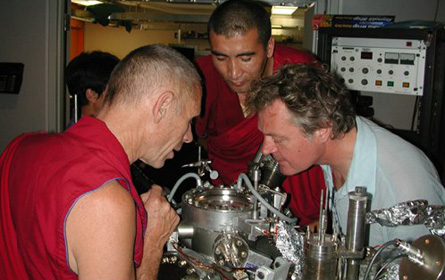This is the second part of an article I was asked to write to explain nanotechnology and the debates surrounding it to a non-scientific audience with interests in social and policy issues. This article was published in the Summer 2007 issue of the journal Soundings. The first installment can be read here.
Ideologies
There are many debates about nanotechnology; what it is, what it will make possible, and what its dangers might be. On one level these may seem to be very technical in nature. So a question about whether a Drexler style assembler is technically feasible can rapidly descend into details of surface chemistry, while issues about the possible toxicity of carbon nanotubes turn on the procedures for reliable toxicological screening. But it’s at least arguable that the focus on the technical obscures the real causes of the argument, which are actually based on clashes of ideology. What are the ideological divisions that underly debates about nanotechnology?
Transhumanism
Underlying the most radical visons of nanotechnology is an equally radical ideology – transhumanism. The basis of this movement is a teleological view of human progress which views technology as the vehicle, not just for the improvement of the lot of humanity, but for the transcendence of those limitations that non-transhumanists would consider to be an inevitable part of the human condition. The most pressing of these limitations, is of course death, so transhumanists look forward to nanotechnology providing a permanent solution to this problem. In the first instance, this will be effected by nanomedicine, which they anticipate as making cell-by-cell repairs to any damage possible. Beyond this, some transhumanists believe that computers of such power will become available that they will constitute true artificial intelligence. At this point, they imagine a merging of human and machine intelligence, in a way that would effectively constitute the evolution of a new and improved version of humankind.
The notion that the pace of technological change is continually accelerating is an article of faith amongst transhumanists. This leads to the idea that this accelerating rate of change will lead to a point beyond which the future is literally inconceivable. This point they refer to as “the singularity”, and discussions of this hypothetical event take on a highly eschatological tone. This is captured in science fiction writer Cory Doctorow’s dismissive but apt phrase for the singularity: “the rapture of the nerds”.
This worldview carries with it the implication that an accelerating pace of innovation is not just a historical fact, but also a moral imperative. This is because it is through technology that humanity will achieve its destiny, which is nothing less that to transcend its own current physical and mental limitations. The achievement of radical nanotechnology is central to this project, and for this reason transhumanists tend to share a strong conviction not only that radical nanotechnology along Drexlerian lines is possible, but also that its development is morally necessary.
Transhumanism can be considered to be the extreme limit of views that combine strong technological determinism with a highly progressive view of the development of humanity. It is a worldwide movement, but it’s probably fair to say that its natural home is California, its main constituency is amongst those involved in information technology, and it is associated predominantly, if not exclusively, with a strongly libertarian streak of politics, though paradoxically not dissimilar views seem to be attractive to a certain class of former Marxists.
Given that transhumanism as an ideology does not seem to have a great deal of mass appeal, it’s tempting to underplay its importance. This may be a mistake; amongst its adherents are a number of figures with very high media profiles, particularly in the United States, and transhumanist ideas have entered mass culture through science fiction, films and video games. Certainly some conservative and religious figures have felt threatened enough to express some alarm, notably Francis Fukuyama, who has described transhumanism as “the world’s most dangerous idea”.
Global capitalism and the changing innovation landscape
If it is the radical futurism of the transhumanists that has put nanotechnology into popular culture, it is the prospect of money that has excited business and government. Nanotechnology is seen by many worldwide as the major driver of economic growth over the next twenty years, filling the role that information technology has filled over the last twenty years. Breathless projections of huge new markets are commonplace, with the prediction by the US National Nanotechnology Initiative of a trillion dollar market for nanotechnology products by 2015 being the most notorious of these. It is this kind of market projection that underlies a worldwide spending boom on nanotechnology research, which encompasses both the established science and technology powerhouses like the USA, Germany and Japan, but also fast developing countries like China and India.
The emergence of nanotechnology has corresponded with some other interesting changes in the commercial landscape in technologically intensive sectors of the economy. The types of incremental nanotechnology that have been successfully commercialised so far have involved nanoparticles, such as the ones used in sunscreens, or coatings, of the kind used in stain-resistant fabrics. This sort of innovation is the province of the speciality chemicals sector, and one cynical view of the prominence of the nanotechnology label amongst new and old companies is that it has allowed companies in this rather unfashionable sector of the market to rebrand themselves as being part of the newest new thing, with correspondingly higher stock market valuations and easier access to capital. On the other hand, this does perhaps signal a more general change in the way science-driven innovations reach the market.
Many of the large industrial conglomerates that were such a prominent parts of the industrial landscape in Western countries up to the 1980s have been broken up or drastically shrunken. Arguably, the monopoly rents that sustained these combines were what made possible the very large and productive corporate laboratories that were the source of much innovation at that time. This has been replaced by a much more fluid scene in which many functions of companies, including research and innovation, have been outsourced. In this landscape, one finds nanotechnology companies like Oxonica, which are essentially holding companies for intellectual property, with functions that in the past would have been regarded as of core importance, such as manufacturing and marketing, outsourced to contractors, often located in different countries.
Even the remaining large companies have embraced the concept of “open innovation”, in which research and development is regarded as a commodity to be purchased on the open market (and, indeed, outsourced to low cost countries) rather than a core function of the corporation. It is in this light that one should understand the new prominence of intellectual property as something fungible and readily monetised. Universities and other public research institutes, strongly encouraged to seek new sources of funding other than direct government support, have made increasing efforts to spin-out new companies based on intellectual property developed by academic researchers.
In the light of all this, it’s easy to see nanotechnology as one aspect of a more general shift to what the social scientist Michael Gibbons has called Mode II knowledge production[4]. In this view, traditional academic values are being eclipsed by a move to more explicitly goal-oriented and highly interdisciplinary research, in which research priorities are set not by the values of the traditional disciplines, but by perceived market needs and opportunities. It is clear that this transition has been underway for some time in the life sciences, and in this view the emergence of nanotechnology can be seen as a spread of these values to the physical sciences.
Environmentalist opposition
In the UK at least, the opposition to nanotechnology has been spearheaded by two unlikely bedfellows. The issue was first propelled into the news by the intervention of Prince Charles, who raised the subject in newspaper articles in 2003 and 2004. These articles directly echoed concerns raised by the small campaigning group ETC[5]. ETC cast nanotechnology as a direct successor to genetic modification; to summarise this framing, whereas in GM scientists had directly intervened in the code of life, in nanotechnology they meddle with the very atomic structure of matter itself. ETC’s background included a strong record of campaigning on behalf of third world farmers against agricultural biotechnology, so in their view nanotechnology, with its spectre of the possible patenting of new arrangements of atoms and the potential replacement of commodities such as copper and cotton by nanoengineered substitutes controlled by multinationals, was to be opposed as an intrinsic part of the agenda of globalisation. Complementing this rather abstract critique was a much more concrete concern that nanoscale materials might be more toxic than their conventional counterparts, and that current regulatory regimes for the control of environmental exposure to chemicals might not adequately recognise these new dangers.
The latter concern has gained a considerable degree of traction, largely because there has been a very widespread degree of consensus that the issue has some substance. At the time of the Prince’s intervention in the debate (and quite possibly because of it) the UK government commissioned a high-level independent report on the issue from the Royal Society and the Royal Academy of Engineering. This report recommended a program of research and regulatory action on the subject of possible nanoparticle toxicity[6]. Public debate about the risks of nanotechnology has largely focused on this issue, fuelled by a government response to the Royal Society that has been widely considered to be quite inadequate. However, it is possible to regret that the debate has become so focused on this rather technical issue of risk, to the exclusion of wider issues about the potential impacts of nanotechnology on society.
To return to the more fundamental worldviews underlying this critique of nanotechnology, whether they be the rather romantic, ruralist conservatism of the Prince of Wales, or the anti-globalism of ETC, the common feature is a general scepticism about the benefits of scientific and technological “progress”. An extremely eloquent exposition of one version of this point of view is to be found in a book by US journalist Bill McKibben[7]. The title of McKibben’s book – “Enough” – is a succinct summary of its argument; surely we now have enough technology for our needs, and new technology is likely only to lead to further spiritual malaise, through excessive consumerism, or in the case of new and very powerful technologies like genetic modification and nanotechnology, to new and terrifying existential dangers.
Bright greens
Despite the worries about the toxicology of nanoscale particles, and the involvement of groups like ETC, it is notable that all-out opposition to nanotechnology has not yet fully crystallised. In particular, groups such as Greenpeace have not yet articulated a position of unequivocal opposition. This reflects the fact that nanotechnology really does seem to have the potential to provide answers to some pressing environmental problems. For example, there are real hopes that it will lead to new types of solar cells that can be produced cheaply in very large areas. Applications of nanotechnology to problems of water purification and desalination have obvious potential impacts in the developing world. Of course, these kinds of problems have major political and social dimensions, and technical fixes by themselves will not be sufficient. However, the prospects that nanotechnology may be able to make a significant contribution to sustainable development have proved convincing enough to keep mainstream environmental movements at least neutral on the issue.
While some mainstream environmentalists may still remain equivocal in their view of nanotechnology, another group seems to be embracing new technologies with some enthusiasm as providing new ways of maintaining high standards of living in a fully sustainable way. Such “bright greens” dismiss the rejection of industrialised economies and the yearning to return to a rural lifestyle implicit in the “deep green” worldview, and look to the use of new technology, together with imaginative design and planning, to create sustainable urban societies[8]. In this point of view, nanotechnology may help, not just by enabling large scale solar power, but by facilitating an intrinsically less wasteful industrial ecology.
Conclusion
If there is (or indeed, ever was) a time in which there was an “independent republic of science”, disinterestedly pursuing knowledge for its own sake, nanotechnology is not part of it. Nanotechnology, in all its flavours and varieties, is unashamedly “goal-oriented research”. This immediately begs the question “whose goals?” It is this question that underlies recent calls for a greater degree of democratic involvement in setting scientific priorities[9]. It is important that these debates don’t simply concentrate on technical issues. Nanotechnology provides a fascinating and evolving example of the complexity of the interaction between science, technology and wider currents in society. Nanotechnology, with other new and emerging technologies, will have a huge impact on the way society develops over the next twenty to fifty years. Recognising the importance of this impact does not by any means imply that one must take a technologically deterministic view of the future, though. Technology co-evolves with society, and the direction it takes is not necessarily pre-determined. Underlying the directions in which it is steered are a set of competing visions about the directions society should take. These ideologies, which often are left implicit and unexamined, need to be made explicit if a meaningful discussion of the implications of the technology is to take place.
[4] Gibbons, M, et al. (1994) The New Production of Knowledge. London: Sage.
[5] David Berube (in his book Nano-hype, Prometheus, NY 2006) explicitly links the two interventions, and identifies Zac Goldsmith, millionaire organic farmer and editor of “The Ecologist” magazine, as the man who introduced Prince Charles to nanotechnology and the ETC critique. This could be significant, in view of Goldsmith’s current prominence in Conservative Party politics.
[6] Nanoscience and nanotechnologies: opportunities and uncertainties, Royal Society and Royal Academy of Engineering, available from http://www.nanotec.org.uk/finalReport.htm
[7] Enough; staying human in an engineered age, Bill McKibben, Henry Hall, NY (2003)
[8] For a recent manifesto, see Worldchanging: a user’s guide for the 21st century, Alex Steffen (ed.), Harry N. Abrams, NY (2006)
[9] See for example See-through Science: why public engagement needs to move upstream, Rebecca Willis and James Wilsdon, Demos (2004)



